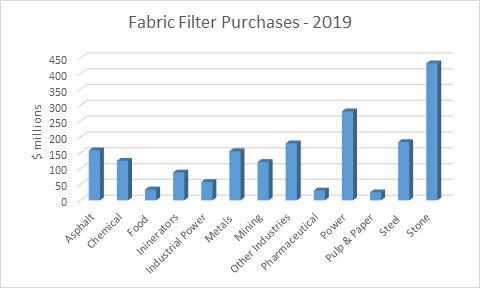
WELCOME
Weekly selected highlights in flow control, treatment and combustion from the
many McIlvaine publications.
Forecasts of Pump Purchases for each of the 6730 Largest Customers
There is a sea change in the way industrial pumps will be purchased in the
future. Join us July 18 at 10:00AM
in a free webinar to discuss this sea change. Here is a summary of what we will
discuss
Pump suppliers are now generating revenues of $56 billion.
However, operators are spending $471 billion per year to own, operate and
maintain those pumps. Furthermore the decisions regarding 84 percent of these
expenditures are being made by 15,000 companies and less than 30,000
individuals, all of whom can be identified and pursued well in time to provide
maximum influence on their choices.
There are 10,000 of the largest pump purchasers who will make 52 percent of the
pump decisions. There are 5,000
consultants, plant and system suppliers who will make 32 percent of the
decisions.
1.
Forecasting the Purchases of Each Company
The first step in navigating the sea change in the market is to forecast the
purchases which will be made by each of these 15,000 companies.
The majority of the purchase decisions will be made by end users.
However plant, system and other suppliers will also be either direct
purchasers or decision makers.
For a new plant (greenfield) the end user is likely to provide a bidder list but
the plant, system supplier or engineering firm will probably make the specific
pump choice.
Most of the replace and upgrade decisions will be made by the end user. The
following chart is from a pump supplier perspective. It segments the present
purchases. It does not include the
associated products sold by non-pump companies such as the VFD, motor or
distributor packages.

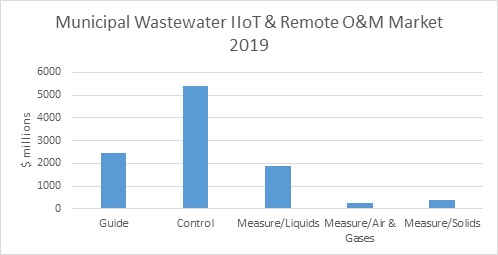
Presently most of the repair and service decisions are made by the end user.
Guide and control revenues generated by pump companies are small.
However, "IIoT and Remote O&M" is creating the sea change in the market and has
the potential to greatly expand pump company revenue and impact market share.
10,000 end users will account for 52 percent of the purchases. 5,000 plant,
system and other suppliers will account for 32 percent of the total. These
targeted companies will spend $47 billion for pumps in 2019.
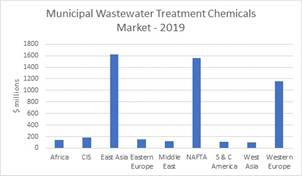
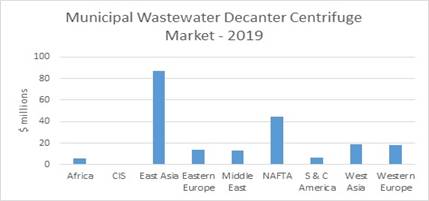
Targets are divided into large and small. 6730 large end users will spend $28.5
billion for pumps next year. This will account for more than 50 percent of total
purchases. Smaller targets will spend 18.5 billion.
|
Large Targeted Company Pump
Purchases 2019 ($ millions) |
||
|
Industry |
# of Companies |
Average per Company |
|
Chemical |
1000 |
1.93 |
|
Electronics |
80 |
1.41 |
|
Flood Control |
100 |
1.18 |
|
Food |
300 |
1.88 |
|
Metals |
100 |
1.71 |
|
Mining |
200 |
8.60 |
|
Oil and Gas |
500 |
15.72 |
|
Other Industries |
1000 |
1.49 |
|
Pharmaceutical |
100 |
6.77 |
|
Power |
200 |
13.96 |
|
Pulp & Paper |
230 |
4.87 |
|
Refinery |
320 |
9.41 |
|
Stone |
600 |
3.42 |
|
Wastewater |
1000 |
2.72 |
|
Water |
1000 |
2.13 |
|
Total |
6730 |
4.23 |
These 6730 companies can be considered the low hanging fruit.
Each will average pump purchases of over $4 million.
The purchasers in the oil and gas and power industries will spend the
most whereas the flood control and electronics companies will spend the least.
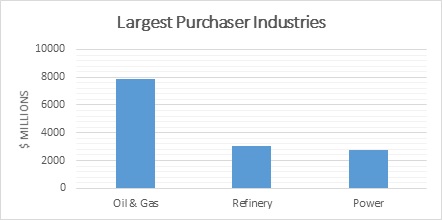
A number of purchasers spend more than $300 million per year for pumps.
|
2019 Pump Purchases by Largest
Customers |
|||
|
Company |
Type |
Corporate Location |
Company Purchases
|
|
Sinopec |
Operator |
China |
607 |
|
Saudi Aramco |
Operator |
Saudi Arabia |
597 |
|
China Nat. Petr. |
Operator |
China |
571 |
|
PetroChina |
Operator |
China |
491 |
|
Guodian/Shenhua |
Operator |
China |
384 |
|
ExxonMobil |
Operator |
U.S. |
359 |
|
Royal Dutch Shell |
Operator |
Netherlands |
353 |
|
Kuwait Petroleum |
Operator |
Kuwait |
336 |
Relatively few A/Es, plant suppliers and system suppliers will account for most
of the $17.9 billion purchased by non-users.
Large power plant system suppliers such as MHPS, Doosan, GE, Siemens and
B&W are major purchasers even though some have a limited range of pumps. Some
large oil and gas contractors have pump divisions but they are mostly in
specialty areas such as oil extraction.
Suez, BEWG and Veolia are examples of companies who both own
water and wastewater plants, operate others and also design and offer
systems using pumps.
Some companies are consultants, OEMs and operators.
Jacobs CH2M designs and builds plants in various industries. It operates
municipal wastewater plants in a number of countries.
Bechtel, SNC Lavalin, and Sinopec are also active in all three
categories. Sinopec spends $700
million/yr for pumps of which $600 million is for chemical and oil/gas
operations and the balance is for design and supply for others.
These purchasers can be identified and pursued in a program offered by the
McIlvaine Company and explained at
www.mcilvainecompany.com
2.
Making the Sale to Each of the 10,000
With increasing use of data analytics and continuous monitoring of pump
performance purchasers will be making very informed decisions. Demonstration of
lowest total cost of ownership will become the basis for making sales.
McIlvaine has extensive services on process systems using pumps. This includes
sedimentation and centrifugation, macrofiltration, cross flow membranes,
cooling, heat exchange systems and boiler feedwater systems.
There are two services on scrubbers. One is for power plant FGD and
another is for industrial scrubbers.
Pump purchases for scrubber systems are $800 million per year. This
includes service and repair parts as well as replacement and greenfield pumps.
It includes both the power plant FGD and the industrial scrubber applications.
Two hundred scrubber companies account for 90 percent of the sales of pumps for
new scrubber systems which amounts to $180 million.
In addition McIlvaine provides Decision Systems for coal fired boilers, gas
turbines, municipal wastewater, ultrapure water and refining.
With these resources pump suppliers can gain the knowledge they need to
make validated lowest total cost of ownership (LTCOV) analyses.
3.
Expanding the Revenue Base with Total Solutions
The pump manufacturers have the opportunity to work with end users as well as
plant and system suppliers to provide edge computer packages built around
continual innovations in pump design and applications.
The revenue potential is somewhere between the present $56 billion and the total
present pump yearly costs of $471 billion.
Pump companies can supply more of the auxiliaries such as variable speed
drives which are now furnished by others.
They can generate additional hardware and service revenues to reduce the
$147 billion spent on pump maintenance.
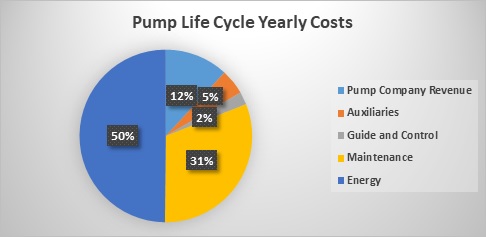
They can provide the guide and control packages to reduce the $235 billion spent
on pump energy. Studies show that
more than 30 percent energy savings is already economical.
Energy costs in the U.S. are less than 50 percent of the costs in Europe
and many Asian countries. So this savings is even more significant outside the
U.S.
Pump companies with knowledge of the processes, the customers site specific
factors and the edge software packages to integrate with end user cloud systems
have the opportunity to expand revenues and more importantly raise EBITA at the
same time.
You can register for the webinar July 18 at
Free
Market Webinars
More information on the business program is found when you
Click Here
Details on the pump market report with forecasts for the 200 top purchasers is
provided at
Advice on the edge computer package and the future of pump automation is found
at
N031 Industrial IOT and
Remote O&M